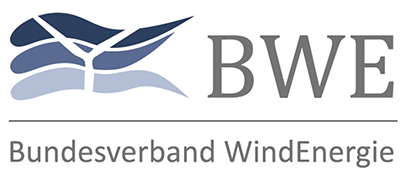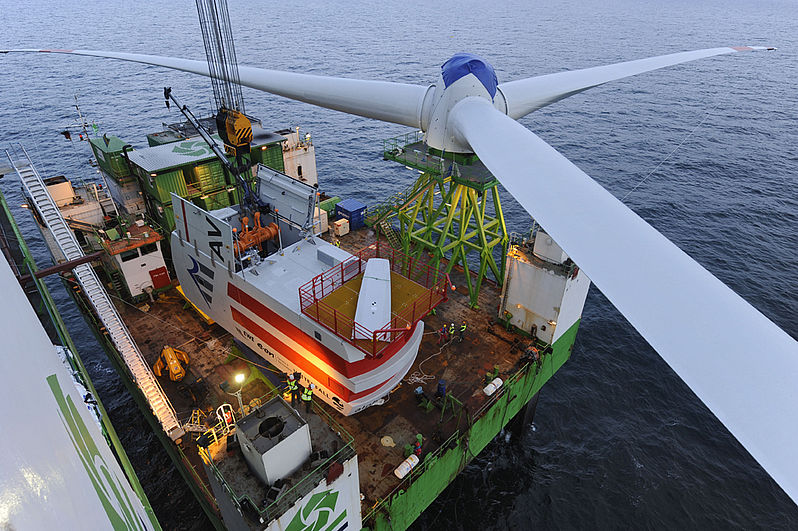Offshore
Offshore wind energy is becoming more and more established in the German electricity mix. By 2030, 30 gigawatts (GW) of power are planned to be installed on the North Sea and Baltic Sea. Continuous expansion enables cost reductions based on optimized plant technology and improved operating concepts. The industry currently employs around 27,000 people.
Strong and constantly blowing winds on the open sea attract attention to offshore wind energy. The energy yield is twice as high as with comparable systems on land due to higher full-load hours. For this reason, offshore wind farms are making a steadily growing contribution to energy supply.
In Germany, expansion is proceeding at full speed. In June 2023, a total of 1,563 offshore wind turbines with a total installed capacity of around 8,400 megawatts (MW) were connected to the grid off the German coasts. Two further offshore wind farms with an output of 500 MW are currently under construction. In the first half of 2023, about 11.3 terawatt hours (million MWh) of electricity were generated by offshore wind energy.
Framework conditions through the Renewable Energy Act
According to the Renewable Energy Act (EEG) 2014, the initial tariff for wind turbines at sea is 15.4 cents per kilowatt hour and will be paid in the first twelve years after commissioning. The basic remuneration is then 3.9 cents per kilowatt hour. The degression provided for in the basic model is 0.5 cents per kilowatt hour from 1 January 2018 and 1 cent per kilowatt hour from 1 January 2020 and 0.5 cents after each additional year. Optionally, operators of offshore plants that are connected to the grid before 1 January 2020 can receive an increased starting tariff of 19.4 cents per kilowatt hour in the first eight years after commissioning (compression model). The reduction in compensation in the compression model is 1 cent per kilowatt hour as of 1 January 2018.
According to EEG 2017, offshore wind energy projects that go into operation after 2021 must apply for funding in tender procedures. The first round of tendering took place in March 2017. By 2018, 3.1 GW of installed capacity will be tendered for starting operations in 2021-2025. From 2021, 700 to 900 MW per year (for commissioning between 2026 and 2030) will then be put out to tender. The target is 15 GW of installed capacity in 2030.
Hightech in North Sea and Baltic Sea
German offshore wind energy operates under special conditions. For reasons of nature conservation (protection of the mudflats) and to exclude effects on the landscape, the German offshore projects - in contrast to Scandinavian and British projects - envisage locations far off the coast at water depths of up to 40 metres. Many suitable areas therefore lie outside the 12 nautical mile zone (of at least 22.2 km from the coast) in the "Exclusive Economic Zone" (EEZ). The technical requirements (foundations, tower construction, cable laying, logistics and maintenance) are many times higher than for the construction of plants directly off the coast. Maintenance on the high seas and regular condition monitoring are also of central importance due to the constant exposure to salt water, storms and tides.
Planning and Permission
The Federal Maritime and Hydrographic Agency (BSH) is responsible for the approval of offshore wind farms outside the 12 nautical mile zone, in other words for locations in the EEZ. Approval is granted after a detailed assessment of the consequences for ecosystems, fisheries, shipping and the military. For applications within the 12 nautical mile zone, the authorities of the respective federal state are responsible.
Coastal regions benefit
The development of the German offshore wind energy use has so far created about 27,000 jobs. These are not only located near the coast, but also in the conurbations of southern and western Germany, where important components such as bearings, gearboxes and generators are manufactured, due to the industrial value chain.
However, the coastal regions benefit in particular from this development. Ports on the North Sea and Baltic Sea have adapted to offshore wind energy. For example, expansion areas for plant and component manufacturers were and are being created and heavy-duty terminals and berths for special ships in the industry are being built. In addition, the necessary load-bearing capacity of the traffic areas was provided to transport the foundations and plant components weighing hundreds of tons.
Employees are trained in service, maintenance and assembly in special training centres. The operation of the systems is monitored in control centres. In addition there are contracted service providers such as helicopter service, logisticians, scientific experts, cable carriers and shipping companies.
Service and maintenance
In the event of turbine failures, operators of offshore wind farms lose a lot of money due to the high yields of multi-megawatt turbines. Especially if the repair is delayed due to the weather. This calls for reliable systems and sophisticated service and maintenance concepts. Electronic remote plant monitoring and redundant systems are standard, regular inspection and maintenance of foundations, rotor blades or cable connections are indispensable. Experts estimate that service and maintenance account for up to a quarter of the costs of offshore wind farms, while the turbines themselves account for around a third.
By way of comparison: on land, the costs of the systems account for two thirds of the total costs, while the share of service and maintenance is in the low single-digit percentage range. In addition to costs, the offshore industry must master challenges in spare parts and personnel logistics. Especially in heavy seas, service teams are exposed to high loads due to several hours of travel and difficult transitions from the ship to the wind turbine. Helicopter transfers are faster but more expensive and often have to be cancelled in fog and strong winds.


